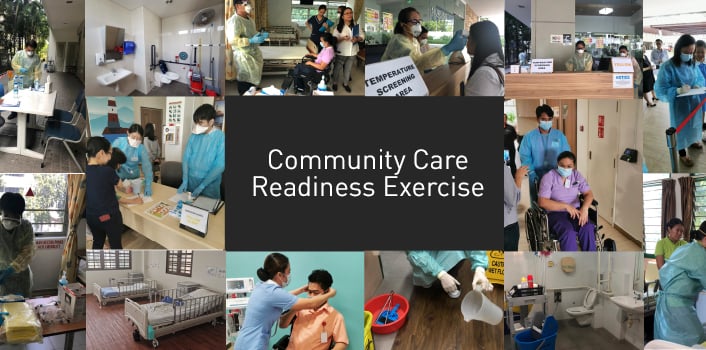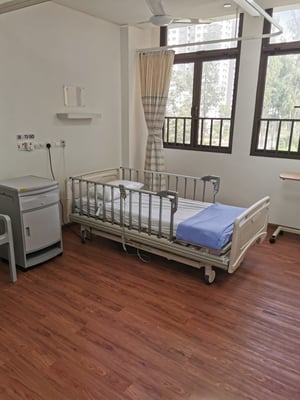
Introduction
BCM Institute has helped Agency for Integrated Care (AIC) to engage, prepare and conduct the Community Care Readiness Exercise, a mass Pandemic Outbreak exercise involving over 70 Nursing Homes and Old Age Healthcare Service Providers across the span of 2 years. Over the many exercises we have helped conduct, we noticed several recurring areas of considerations that we feel necessary to highlight for future Homes to take note of when creating their Pandemic Preparedness plans.
Suspect Management

As pandemics are large-scale outbreaks of infectious disease such as the outbreak in Singapore in 2003, demonstrate that the need to prepare the citizen can greatly decrease the morbidity and mortality throughout a country. During a outbreak, while transiting from small group of infected citizens to the masses, the need to have a system to managed any "suspected" person becomes one of the most important steps to be taken.
In this blog, we will start with the strict protocol to prevent a "suspected" case from entering the Nursing Home. These are some of the leanings from the exercises that was conducted b BCM Institute.
Temperature Screening Station

During the "'Disease Outbreak Response System Condition" or DORSCON alert issued by the Ministry of Health, Singapore or MOH, it will inform Nursing Homes to set up Temperature Screening stations for the purpose of screening visitors into the Nursing Home, filtering out those who have recently returned from at-risk countries and/or are exhibiting symptoms of the infectious disease.
The Donning & Doffing of PPE
-
Staff assigned to the Temperature Screening Station sho
-
uld have already donned the PPE gown, mask, and gloves prior to interacting with any would- be visitors approaching
Temperature Screening Form
- Every Temperature Screening Station should have a stack of Temperature Screening Forms for staff to fill in key information, including the recent places of travel and/or whether the visitor is exhibiting any symptoms.
- As visitors may fill in the form erroneously, it is vastly preferable if staff fill in the information for them
Cooling Station
- Sometimes a fever may actually not be a fever. Sometimes a visitor may appear feverish due to the hot weather of any particular day. Thus, it is important to have a cooling station for visitors to cool down before they return to have their temperature taken again. Alternatively, and if space is available, a cooling room can also be designated.
Separate Entry/Exit points
- To prevent cross-contamination, entry and exit points should be distinct and, if applicable, separated by a physical barrier.
Health Advisory Signs
- Important Signage (Hand Hygiene, Health Advisory, Hotline. Etc.) posters should be placed up around the Temperature Screening Station. They should ideally be readily visible, come in all 4 different Singaporean languages, and have sufficient visual aides to convey their point across
Colored Stickers
- To differentiate between visitor status, colored stickers should be pasted upon visitors after a screening check is complete. Different stickers should be used on different days to prevent visitors from reusing them to bypass a screening during a return visit.
Information Management
- Our concern is that some visitors may not be honest, truthful, or forthcoming with the countries they have visited or the symptoms they may have.
- Often, the visitors may try to downplay their symptoms or may simply not see it as a significant health hazard for the residents of the Home.
- It is important that screening staff help the visitors fill in the Screening form, asking questions where necessary, in order to minimize the margin of error caused by omission of details that may occur if the visitors were to fill it in themselves.
Finding Alternative Ways to Visit
- Even though some visitors ay be deemed as a potential health hazard to the residents within the Home, it is not impossible for them to talk to their NOK inside.
- Rather than face to face, a Home could provide video conferencing to allow the visitor to talk and interact with the resident he intended to visit.
Resident Management
During a DORSCON period, it is key that staff are on the look out for residents displaying symptoms common to the infectious disease in question. Once identified, clinical staff should segregate the resident turned suspect case from the general ward population as quickly as possible.
Isolation Room

When a suspect case is identified and an ambulance is called, the suspect case is first escorted to an isolation room to wait until the ambulance arrives. An ideal Isolation room should possess the following amenities and/or considerations:
- Assisted bath and toilet
- Provision of openable external window(s) to permit flushing of the room air.
- Hand hygiene facilities
- Bed
- Bio hazard Bin Collection point both inside and outside the isolation room
- A pre-determined emergency route to the ambulance pickup point
- Corridors wide enough to allow a stretcher to pass through
- A protocol to cordon off any the evacuation route while evacuating the suspect case
- Signage indicating that the room in question has been designated an isolation room



